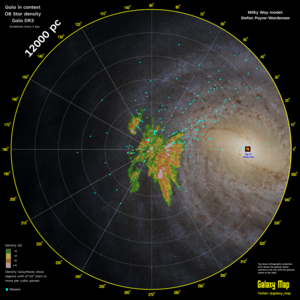
A galaxy is a system of stars, stellar remnants, interstellar gas, dust, and dark matter bound together by gravity. The word is derived from the Greek galaxias (γαλαξίας), literally 'milky', a reference to the Milky Way galaxy that contains the Solar System. Galaxies, averaging an estimated 100 million stars, range in size from dwarfs with less than a thousand stars, to the largest galaxies known – supergiants with one hundred trillion stars, each orbiting its galaxy's center of mass. Most of the mass in a typical galaxy is in the form of dark matter, with only a few percent of that mass visible in the form of stars and nebulae. Supermassive black holes are a common feature at the centres of galaxies.

The IC 342/Maffei Group corresponds to one or two galaxy groups close to the Local Group. The member galaxies are mostly concentrated around either IC 342 or Maffei 1, which would be the brightest two galaxies in the group. The group is part of the Virgo Supercluster. However, recent studies have found that the two subgroups are unrelated; while the IC 342 group is the nearest galaxy group to the Milky Way, the Maffei 1 group is several times farther away, and is not gravitationally bound to the IC 342 group.
The following is a timeline of galaxies, clusters of galaxies, and large-scale structure of the universe.

The Great Attractor is a region of gravitational attraction in intergalactic space and the apparent central gravitational point of the Laniakea Supercluster of galaxies that includes the Milky Way galaxy, as well as about 100,000 other galaxies.

The Two Micron All-Sky Survey, or 2MASS, was an astronomical survey of the whole sky in infrared light. It took place between 1997 and 2001, in two different locations: at the U.S. Fred Lawrence Whipple Observatory on Mount Hopkins, Arizona, and at the Cerro Tololo Inter-American Observatory in Chile, each using a 1.3-meter telescope for the Northern and Southern Hemisphere, respectively. It was conducted in the short-wavelength infrared at three distinct frequency bands near 2 micrometres, from which the photometric survey with its HgCdTe detectors derives its name.
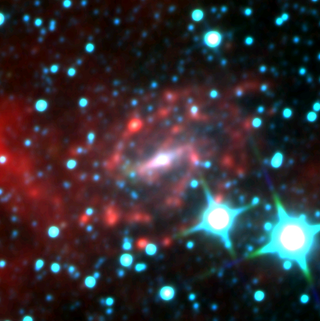
Dwingeloo 1 is a barred spiral galaxy about 10 million light-years away from the Earth, in the constellation Cassiopeia. It lies in the Zone of Avoidance and is heavily obscured by the Milky Way. The size and mass of Dwingeloo 1 are comparable to those of Triangulum Galaxy.
Dwingeloo 2 is a small irregular galaxy discovered in 1996 and located about 10 million light-years away from the Earth. Its discovery was a result of the Dwingeloo Obscured Galaxy Survey (DOGS) of the Zone of Avoidance using the Dwingeloo Radio Observatory. Dwingeloo 2 is a companion galaxy of Dwingeloo 1.

The Sombrero Galaxy is a peculiar galaxy of unclear classification in the constellation borders of Virgo and Corvus, being about 9.55 megaparsecs from the Milky Way galaxy. It is a member of the Virgo II Groups, a series of galaxies and galaxy clusters strung out from the southern edge of the Virgo Supercluster. It has an isophotal diameter of approximately 29.09 to 32.32 kiloparsecs, making it slightly bigger in size than the Milky Way.
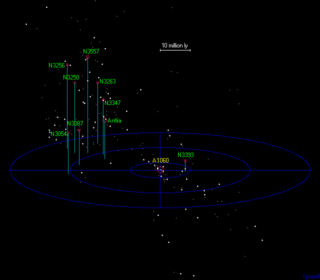
The Hydra–Centaurus Supercluster, or the Hydra and Centaurus Superclusters, is a supercluster in two parts, the closest neighbour of Virgo Supercluster. It is located about 39 Mpc (127 Mly) away.
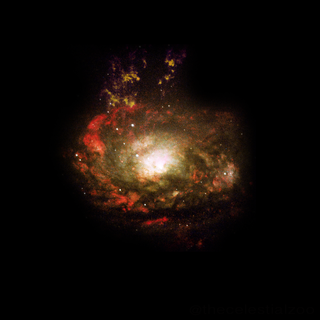
The Circinus Galaxy is a Seyfert galaxy in the constellation of Circinus. It is located 4 degrees below the Galactic plane, and, at a distance of 4.0 Mpc (13 Mly), is one of the closest major galaxies to the Milky Way. The galaxy is undergoing tumultuous changes, as rings of gas are likely being ejected from the galaxy. Its outermost ring is 1400 light-years across while the inner ring is 260 light-years across. Although the Circinus galaxy can be seen using a small telescope, it was not noticed until 1977 because it lies close to the plane of the Milky Way and is obscured by galactic dust. The Circinus Galaxy is a Type II Seyfert galaxy and is one of the closest known active galaxies to the Milky Way, though it is probably slightly farther away than Centaurus A.

The Norma Cluster (ACO 3627 or Abell 3627) is a rich cluster of galaxies located near the center of the Great Attractor; it is about 68 Mpc (222 Mly) distant. Although it is both nearby and bright, it is difficult to observe because it is located in the Zone of Avoidance, a region near the plane of the Milky Way. Consequently, the cluster is severely obscured by interstellar dust at optical wavelengths. Its mass is estimated to be on the order of 1015 solar masses.

The Milky Way is the galaxy that includes the Solar System, with the name describing the galaxy's appearance from Earth: a hazy band of light seen in the night sky formed from stars that cannot be individually distinguished by the naked eye.
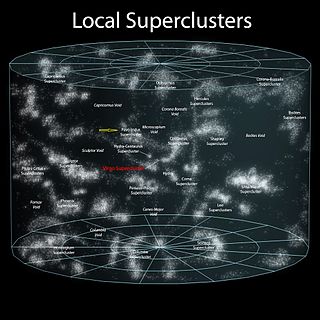
The Pavo–Indus Supercluster is a neighboring supercluster located about 60–70 Mpc (196–228 Mly) away in the constellations of Pavo, Indus, and Telescopium. The supercluster contains three main clusters, Abell 3656, Abell 3698, and Abell 3742.

In cosmology, galaxy filaments are the largest known structures in the universe, consisting of walls of galactic superclusters. These massive, thread-like formations can commonly reach 50/h to 80/h Megaparsecs —with the largest found to date being the Hercules-Corona Borealis Great Wall at around 3 gigaparsecs (9.8 Gly) in length—and form the boundaries between voids. Due to the accelerating expansion of the universe, the individual clusters of gravitationally bound galaxies that make up galaxy filaments are moving away from each other at an accelerated rate; in the far future they will dissolve.

Maffei 1 is a massive elliptical galaxy in the constellation Cassiopeia. Once believed to be a member of the Local Group of galaxies, it is now known to belong to a separate group, the IC 342/Maffei Group. It was named after Paolo Maffei, who discovered it and the neighboring Maffei 2 in 1967 via their infrared emissions.

Maffei 2 is an intermediate spiral galaxy about 10 million light-years away in the constellation Cassiopeia. Maffei 2 and Maffei 1 were both discovered by Paolo Maffei in 1968 from their infrared emission. Maffei 2 lies in the Zone of Avoidance and is about 99.5% obscured by the Milky Way's foreground dust clouds, and as a result is barely detectable at optical wavelengths. It had been suggested soon after its discovery that Maffei 2 may be a member of the Local Group, but it is now thought to be a member of another nearby group, the IC 342/Maffei Group, the galaxy group that is the closest to the Local Group.
The Taurus Void is a vast, near-empty region of space situated between the Perseus–Pisces Supercluster and the Virgo Supercluster. The Taurus void is unique because of its relatively close proximity to Earth, and because it helps to define the edge of latter's home supercluster, the Virgo Supercluster. Despite its close proximity to Earth, the Taurus Void is not well-studied because it is partially obscured by the Milky Way when viewed from Earth. In contrast to its ambiguous boundary in the section of sky obscured by the Milky Way, the Taurus Void has a very well-defined boundary with the Perseus-Pisces supercluster.
The Vela Supercluster (Vela SCl, VSCL) is a massive galactic supercluster about 265.5 megaparsecs (870 million light-years) away within the vicinity of the Zone of Avoidance, centered on the constellation Vela. It is one of the largest structures found in the universe, covering about 25 × 20 degrees of the sky. It consists of two walls: a broad main wall and a secondary merging wall. The combined dimensions of the walls are 115 km/s Mpc on the major dimensions and 90 km/s Mpc on the minor ones, which corresponds to about 385 million and 300 million light years, respectively. It is about 1,000 times the mass of the Milky Way galaxy, which corresponds to a mass of 1 × 1015 M☉. About 20 initial galaxy clusters have been identified spectroscopically.

NGC 3256 is a peculiar galaxy formed from the collision of two separate galaxies in the constellation of Vela. NGC 3256 is located about 100 million light-years away and belongs to the Hydra–Centaurus Supercluster complex. NGC 3256 provides a nearby template for studying the properties of young star clusters in tidal tails. The system hides a double nucleus and a tangle of dust lanes in the central region. The telltale signs of the collision are two extended luminous tails swirling out from the galaxy. The tails are studded with a particularly high density of star clusters. NGC 3256 is the most luminous galaxy in the infrared spectrum located within z 0.01 from Earth.

NeVe 1 is a supergiant elliptical galaxy, which is the central, dominant member and brightest cluster galaxy (BCG) of the Ophiuchus Cluster. It lies at a distance of about 411 million light-years away from Earth and is located behind the Zone of Avoidance region in the sky. It is the host galaxy of the Ophiuchus Supercluster eruption, the most energetic astronomical event known.

